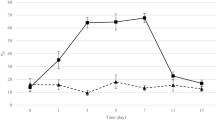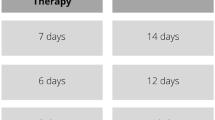Abstract
The effect on the faecal aerobic and anaerobic flora of ciprofloxacin given in low doses for selective decontamination of the digestive tract was investigated in ten human volunteers. The volunteers received 50, 100 and 200 mg of ciprofloxacin every 12 h for five days at intervals of three and five weeks respectively. No significant differences in the numbers of aerobes or anaerobes were seen after the 2 × 50 mg regime. The colony counts of most anaerobes and the total aerobe count were significantly decreased after the 2 × 200 mg regime. Whereas the aerobe count was also significantly decreased after administration of 2 × 200 mg, the anaerobe count remained stable.Clostridium difficile was not detected during or after treatment. From these results it can be concluded that ciprofloxacin in a dose of 2 × 100 mg can be recommended for selective decontamination of the digestive tract.
Similar content being viewed by others
References
Rozenberg-Arska M, Dekker AW, Verhoef J: Ciprofloxacin for selective decontamination of the alimentary tract in patients with acute leukemia during remission induction treatment: the effect on fecal flora. Journal of Infectious Diseases 1985, 152: 104–107.
Brumfitt W, Franklin I, Grady D, Hamilton-Miller JMT, Hiffe A: Changes in the pharmacokinetics of ciprofloxacin and faecal flora during administration of a 7-day course to human volunteers. Antimicrobial Agents and Chemotherapy 1984, 26: 757–761.
de Vries-Hospers HG, Welling GW, van der Waaij D: Influence of quinolones on throat and faecal flora of helathy volunteers. Pharmaceutisch Weekblad Scientific Edition 1987, 9, Supplement: 41–44.
Sutter VL, Kwok Y-Y, Bulkacz J: Comparative activity of ciprofloxacin against anaerobic bacteria. Antimicrobial Agents and Chemotherapy 1985, 27: 427–428.
Edlund C, Lindqvist L, Nord CE: Norfloxacin binds to human fecal material. Antimicrobial Agents and Chemotherapy 1988, 32: 1869–1874.
van der Waaij D: Colonization resistance of the digestive tract: clinical consequences and implications. Journal of Antimicrobial Chemotherapy 1982, 10: 263–270.
Borriello SP, Barclay FE, Welch AR: Evaluation of the predictive capability of an in vitro model of colonization resistance toClostridium difficile infection. Microbial Ecology in Health and Disease 1988, 1: 61–64.
Holdeman LV, Cato EP, Moore WEC (ed.): Anaerobe laboratory manual. Virginia Polytechnic Institute, Blacksburg, VA, USA 1977, p. 12, 72, 124, 125, 134.
Meijer-Severs GJ, van Santen E: Variations in the anaerobic faecal flora of ten healthy human volunteers with special reference to theBacteroides fragilis group andClostridium difficile. Zentralblatt für Bakteriologie und Hygiene (A) 1986, 261: 43–52.
Sutter VL, Citron DM, Edelstein MAC, Finegold SM: Wadsworth anaerobic bacteriology manual. Star Publishing, Belmont, CA, USA, 1985, p. 95.
Author information
Authors and Affiliations
Rights and permissions
About this article
Cite this article
Meijer-Severs, G.J., van Santen, E. & de Vries-Hospers, H.G. Low-dose ciprofloxacin for selective decontamination of the digestive tract in human volunteers. Eur. J. Clin. Microbiol. Infect. Dis. 9, 285–287 (1990). https://doi.org/10.1007/BF01968063
Issue Date:
DOI: https://doi.org/10.1007/BF01968063




